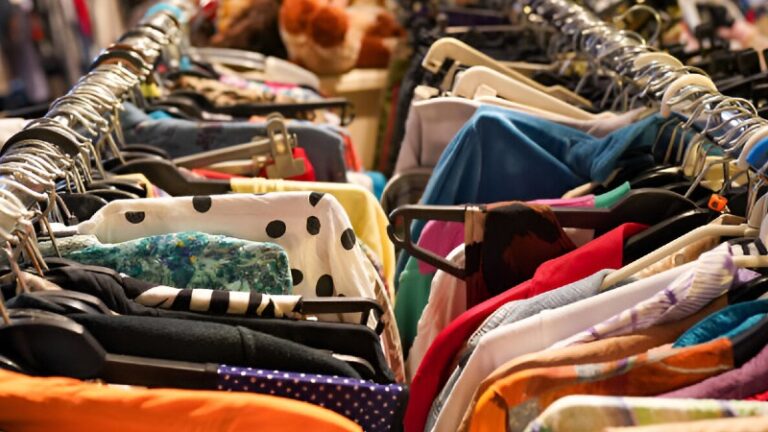Why Thrift Store Shopping Matters
Thrifting is no longer just about saving money. Today, it plays a central role in:
- Sustainability: Extending the lifecycle of clothing reduces textile waste and the carbon footprint of fast fashion.
- Affordability: Shoppers can access quality brands and timeless pieces at a fraction of retail cost.
- Creativity: Unique finds allow for personal style expression that mass-produced fashion can’t replicate.
- Community Impact: Many thrift stores are operated by charities, so purchases often fund local initiatives.
Think Like a Curator, Not Just a Shopper
Most guides focus on finding cheap deals, but the most successful thrifters view themselves as curators of a collection. Instead of chasing random bargains, think about how each piece contributes to your wardrobe, home, or lifestyle. This mindset elevates thrifting from impulse-buying into an intentional and rewarding experience.
Practical Example
Rather than buying a $3 blouse just because it’s inexpensive, ask yourself: Does this fit into my overall style? Will I wear it at least 10 times? The answer will determine whether the bargain is truly valuable.
How to Prepare Before You Thrift
Preparation is half the battle. Walking into a thrift store without a strategy can feel overwhelming. Here are the steps to get started:
- Define Your Style Goals: Are you searching for office staples, weekend wear, or vintage collectibles?
- Make a Flexible List: Instead of a black floral midi skirt, write midi skirts. This increases your chances of finding a match.
- Set a Budget: Thrift stores can be surprisingly tempting. Decide how much you want to spend before walking in.
- Bring Essentials: A tape measure for checking sizes, reusable bags, and a small bottle of hand sanitizer go a long way.
Mastering the In-Store Experience
Start With a Section Strategy
Instead of browsing aimlessly, focus on two or three sections per visit. For example, shirts, shoes, and outerwear. This keeps you from getting overwhelmed and helps you make thoughtful decisions.
Think Beyond Gender Labels
Some of the best finds hide in unexpected places. Men’s sections often have oversized blazers, sturdy denim, or cozy sweaters that can be styled creatively. Bedding sections sometimes hold high-quality fabrics that can be repurposed into curtains, tablecloths, or sewing projects.
Timing Is Everything
New stock usually arrives after weekend donations, making Mondays and Tuesdays prime browsing days. Similarly, mornings are often less crowded, giving you the best chance at freshly stocked items.
How to Spot Quality Quickly
One of the biggest challenges in thrift shopping is separating true gems from items that won’t last. Use this quick checklist:
- Check Fabric Labels: Natural fibers (cotton, linen, wool, silk) usually last longer than synthetics.
- Examine Stitching: Loose threads or uneven seams often signal poor quality.
- Look for Brand Tags: Recognizable, reputable brands can be resold or worn for years.
- Inspect Closely: Hold items up to the light to check for stains, tears, or thinning fabric.
Thrifting Economics
While thrifting is often about bargains, understanding the actual economics can make you a smarter shopper.
| Item | Average Retail Price | Average Thrift Price | Potential Savings |
|---|---|---|---|
| Levi’s Jeans | $70–$100 | $8–$15 | 80–85% |
| Wool Sweater | $60–$120 | $7–$12 | 85–90% |
| Blazer (Wool/Poly Blend) | $80–$200 | $10–$25 | 75–85% |
| Home Décor (Ceramic Vase) | $30–$60 | $3–$7 | 80–90% |
Online Thrifting
If your local stores are limited, online platforms open a new world of secondhand shopping. Each platform has its quirks:
- Depop: Trend-driven, but watch for inflated prices.
- Vinted: Often more affordable and community-driven.
- eBay: Great for auctions and rare finds.
- Etsy: Curated vintage sellers, typically higher prices but quality assurance.
Pro Tip
Always search by brand and filter by size. Saving favorite searches helps you track when new items are posted.
Common Mistakes to Avoid
- Buying Too Much: Cheap items add up. Only buy what fits your style and wardrobe.
- Ignoring Care Instructions: Dry-clean-only items may cost more in the long run.
- Overlooking Alterations: Don’t dismiss a piece because of minor issues; small fixes can make big differences.
- Forgetting Hygiene: Always wash or sanitize thrifted clothing before use.
The Emotional Payoff of Thrifting
Thrifting isn’t only practical it’s emotionally rewarding. The joy of telling someone I got it at Goodwill or the thrill of scoring a one-of-a-kind vintage jacket connects you with the story of the item. Every thrifted piece carries history, which makes your wardrobe or home feel unique and meaningful.
Conclusion
The ultimate guide to thrift store shopping is not about quantity it’s about quality, creativity, and intentionality. By thinking like a curator, preparing with strategy, and shopping with care, you’ll transform thrifting into more than a pastime. It becomes a lifestyle one that saves money, reduces waste, and creates stories worth telling.
Frequently Asked Questions (FAQs)
What is the best time to shop at thrift stores?
Most thrift stores receive new donations after the weekend, making Mondays and Tuesdays the best days to find freshly stocked items. Early mornings are typically less crowded, giving you a better chance to browse in peace.
How can I find quality clothing in thrift stores?
Check fabric labels for natural fibers, inspect stitching, look for reputable brands, and hold items up to the light to spot stains or wear. Quality items tend to last longer and maintain their style.
Is thrifting really sustainable?
Yes! By buying second-hand items, you reduce textile waste, lower your carbon footprint, and prevent fast fashion overproduction. Each purchase supports sustainable and eco-friendly consumer habits.
Can I thrift online as well as in-store?
Absolutely. Platforms like Depop, Vinted, eBay, and Etsy allow you to shop second-hand items from home. Just be mindful of inflated prices and search by brand or category to find the best deals.
What should I avoid when thrift shopping?
Avoid buying too many items impulsively, neglecting care instructions, ignoring minor damages that could be repaired, or forgetting to wash items before use. Intentional and informed shopping is key.


